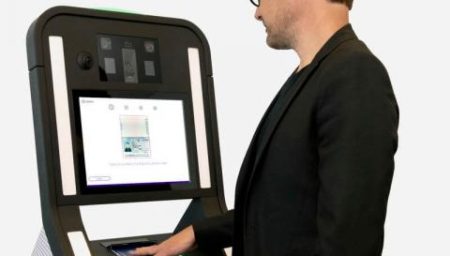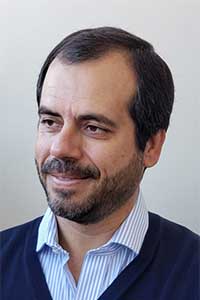Providing fast, accurate and reliable traveler registration and identity verification

 Emmanuel Wang: Unfortunately, the pandemic is not over yet and air traffic is still suffering from the uncertainties of this crisis. However, the air transport ecosystem has continued to innovate by implementing solutions that have permitted airports and airlines to reassure governments and travelers that it is safe to travel again. Certain solutions were already being discussed before Covid-19 by international organizations such as IATA, ACI, ICAO, etc. The pandemic accelerated the deployment of contactless solutions, remote check-in, and the digitization of services at airports.
Emmanuel Wang: Unfortunately, the pandemic is not over yet and air traffic is still suffering from the uncertainties of this crisis. However, the air transport ecosystem has continued to innovate by implementing solutions that have permitted airports and airlines to reassure governments and travelers that it is safe to travel again. Certain solutions were already being discussed before Covid-19 by international organizations such as IATA, ACI, ICAO, etc. The pandemic accelerated the deployment of contactless solutions, remote check-in, and the digitization of services at airports.
 Pedro Alves: The industry has demonstrated great resilience, strengthening the collaboration between the multiple stakeholders and consolidating the use of biometrics and automation. Additionally, many pilot programs have been conducted during this difficult period to enable a safer and more convenient travel experience. It has been a privilege for IDEMIA to participate in numerous innovative initiatives around the world, such as the MONA program with VINCI Airports in Lyon Saint-Exupéry Airport and Group ADP in Paris Orly Airport in France, Medellin Airport in Colombia, and Barcelona Airport Josep Tarradellas Barcelona-El Prat Airport in Spain.
Pedro Alves: The industry has demonstrated great resilience, strengthening the collaboration between the multiple stakeholders and consolidating the use of biometrics and automation. Additionally, many pilot programs have been conducted during this difficult period to enable a safer and more convenient travel experience. It has been a privilege for IDEMIA to participate in numerous innovative initiatives around the world, such as the MONA program with VINCI Airports in Lyon Saint-Exupéry Airport and Group ADP in Paris Orly Airport in France, Medellin Airport in Colombia, and Barcelona Airport Josep Tarradellas Barcelona-El Prat Airport in Spain.
E.W: Yes, facial recognition is being used at many airports to increase security and passenger convenience. It is being tested in the Sao Paulo – Rio de Janeiro shuttle as well as at Lyon-Saint Exupéry Airport in France, and it used at Changi Airport-T4 since 2017. According to the Global Passenger Survey carried out by IATA in 2021, 73% of travelers are interested in the idea of using their biometrics to speed up airport processes while offering a touchless experience. In 2021, we worked on improving our facial recognition algorithms so that they are efficient even when passengers are wearing a facemask.
P.A: The use of biometrics is gaining even more traction across the globe, with many biometric programs in the United States. Our solutions are present at Los Angeles International Airport to streamline the boarding process. At Oakland International Airport, US, we provide frictionless face biometrics, optimizing the travel experience while supporting the airport as they meet existing Customs and Border Protection requirements for outbound flights. IDEMIA’s technology significantly speeds up passenger clearance, as it can recognize passenger faces within fractions of a second, with absolutely no compromise on security. It requires no touch and limits interaction with the system, making the boarding process as stress-free as possible for passengers. Finally, at Newark our technology helps verify the identity of passengers taking international flights, and passengers can use the biometric self-boarding eGate pilot.
E.W: The efficiency of our solutions and our expertise is recognized globally. We have won many EU-EES contracts, and our programs are being rolled out in quick succession. In 2021, we started the implementation of two complete programs that combined systems and equipment in Iceland and Denmark. This will bring border control in these Schengen Member States into compliance with the new regulations introducing greater security through the use of multibiometrics.
Last summer, the self-service immigration pre-check kiosks and counters were installed at Keflavik Airport in Iceland. The first testing center was delivered to Denmark for deployment in the coming months at nine airports and 14 police districts. In 2022, IDEMIA will deliver self-service kiosks to the Netherlands, which passengers will be able to use to pre-enroll into EU Entry/Exit System (EU-EES). We will also be equipping Lithuania and Estonia with face capture equipment, and Romania will soon be deploying the on the move facial recognition technology, MFACE, at the country’s land and sea borders.
P.A: And beyond Europe, we are seeing an increase in the use of innovative technology at many airports across the globe, even with different paces towards recovery. For instance in Asia, IDEMIA is extremely proud of equipping one of the most technologically advanced countries in the world with integrated border control solutions. Our Automated Border Control Gates have been deployed at two airport terminals and at a major land border-crossing point in South East Asia.
The globalization of trade leads us to believe that market evolution is rather consistent between South East Asia, Europe, North America, Latin America and the Middle East. The pandemic has accelerated the transformation of Governments border management methods; biometric technologies have helped reduce health risks by optimizing the management of passenger flows, while providing a more convenient experience. IDEMIA has also developed a solution to facilitate interoperable issuance and verification of ICAO Visible Digital Seal known as the Health Travel Pass, which is ready for the next step of automation. It will assist airlines and governments to verify the health status of travelers in order to reduce risks and facilitate traveling.
E.W: Airports still need to optimize their infrastructures to offer a more pleasant travel experience and reduce physical contact. And this is why we will see an increase in the use of automated self-services, and multibiometric and contactless technologies. Our self-service TravelKiosk has an integrated MorphoWave device, allowing travelers to complete contactless fingerprint capture and immigration pre-checks autonomously. This solution is currently being tested in Iceland.
As part of the strategy to secure their territory, governments have started checking the health certificate of passengers at the border. This valuable data in addition to Advance Passenger Information and Passenger Name Record could be analyzed using risk assessment procedures, enabling the relevant government agencies to make decisions in advance.
P.A: Identity management and multibiometrics are key trends that will continue in 2022, facilitating the recovery of the entire travel industry. And we see a trend to have these incorporated across the different infrastructures, for example at land and sea borders where mobile forces operate in challenging environments. It is of the utmost importance to have handheld solutions supporting an increased demand for mobile solutions, like IDEMIA ID Screen 60, which is a rugged multibiometric tablet that allows border guards to securely enroll and verify the identity of travelers, anytime and anywhere in total security. The Romanian government has chosen ID Screen 60 to facilitate the biometric enrollment and identity verification of third country nationals at its borders.
These are just examples of the path the travel industry has taken. 2022 will be fully under the theme of security, safety and health risk mitigation measures by implementing new technology.

Latest News